The North American model of wildlife management, more than a century ago, was based on the then revolutionary, non-European concept, that the fish and game belong to all the people, not just the idle rich gentry on whose land the critters happen to reside.
Except for unscientific and dangerous forays into game ranching and fish farming, public ownership of the fish and game remains a prime management principle today, along with the caveat that a member of the public may acquire legal possession and ownership of fish and game only by obeying Wildlife Acts, Game Acts, Fisheries Acts, and the regulations passed to enforce them.
Section 7 of The Wildlife Act states simply: “the property in all live wildlife in Alberta is vested in the crown,” and section 8 says that the property in dead wildlife remains with the Crown unless the minister transfers it, or the animal has been lawfully hunted, tagged, etc.
So, where does that leave the many hunters I know who are proud to use up one of their precious tags on a fresh road kill, process the meat, and add it to their freezer? Charged and convicted, I suspect, on the unlucky and unlikely chance that a patrolling wildlife officer catches them in the act.
There are people I know, here and in the U.S., who, tags or not, dine well and cheaply on road kill. There is even the best-selling, serio-comic The Original Road Kill Cookbook, by Buck Peterson dealing with how to prepare “yellow line yummies,” and commecing with the first line : “Have you ever noticed how fat game warden’s children are?”
There is even Flattened Fauna, by Roger M. Knutson, a field guide for road kill foragers.
In Montana recently, Bob Ream, head of the state Fish, Wildlife and Parks Commission, ignorant of one of the laws he administers, struck and killed a deer with his vehicle, tagged it and took it for processing — and did not find out what he had done was illegal until he mentioned it to a game warden.
Ream was issued a warning requiring him to donate the meat to a food bank.
It is when we get into trade or trafficking in parts of wildlife that matters can quickly go from the sublime to the ridiculous.
In Ontario recently, wildlife officers noticed an internet ad by someone offering a mounted set of moose antlers for sale. They tracked down a 19 year old student who had bought the antlers at an antique shop for use as a prop in a school play, then tried to re-sell them.
The kid was issued a $250 ticket for illegally selling wildlife and decided to fight it. The justice of the peace threw this one out on the common law principal of triviality.
What would have happened with a similar case in Alberta is a moot point, because our Wildlife Act does not deal with parts of wildlife in its prohibitions against trafficking in wildlife, a serious defect, in my opinion.
There is a major market available for mounted big game trophies. Step into a big box Cabelas or Bass Pro store and you will be met with walls, cliffs, jungles of outstanding mounted big game trophies, all bought for very big bucks, either from the original hunters, or from subsequent owners.
Cabelas, for example, own the mount of the Boone and Crockett number one typical mule deer taken by Doug Burris Jr. in Colorado in 1972, probably bought for huge bucks.
The one big game trophy so outstanding that it will probably never be surpassed, is the #1 B&C non-typical mule deer buck taken by Ed Broder at Chip Lake, Alberta in 1926.
After Ed’s death and a long, sordid, ugly court case among his children that ended in 2004, this absolutely stunning Alberta trophy was sold to Don Schaufler, a Billings, Montana antler buyer for $225,000. Saskite Milo Hansen still owns his world record typical white tail, taken near Biggar in 1993, and wealthy American, Guinn Crousen still owns the world record big horn sheep he bought and shot on Luscar Mountain, Alberta in 2000.
Aside from snipping the occasional supply of prime fly tying materials from groundhogs, foxes, badgers and that ilk, even skunks, my major road kill event came several years ago when a whitetail buck with the best rack I have ever seen on a living animal all but totaled my beloved diesel 1987 Landcruiser, then disappeared into a huge roadside tangle of shoulder high sweet clover.
Briefly I considered following and harvesting that huge rack. But no, it was pitch dark in July: no season, no tag; totally illegal.
Besides, if he was not really dead, just hurting and furious, the buck, in the thick cover and dark could easily skewer me like so much shish kebob … road kill a la Robert.
The next day, broad daylight showed someone else had found the big buck and hauled him away.
Bob Scammell is an award-winning outdoors writer living in Red Deer.
